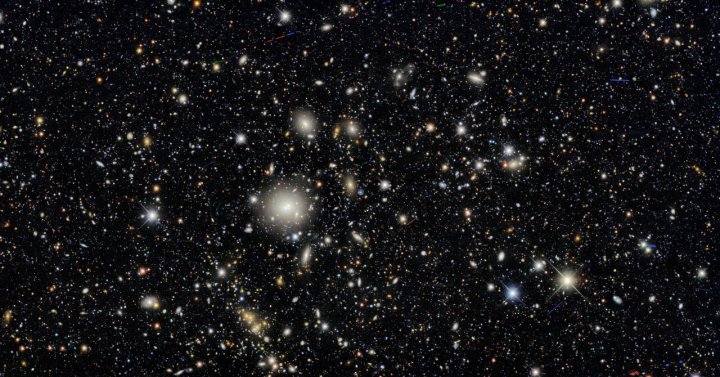
We can’t see it, but we know it’s there: The mystery of dark matter has been puzzling astronomers since the 1930s. We know that ordinary matter makes up just 5% of all that exists in the universe, with the remaining 68% being made up of dark energy and 27% of dark matter. But the exact nature of this matter and energy remains a subject of debate.
To learn more, a project called the Dark Energy Survey (DES) has observed more than 226 million galaxies covering one-eighth of the sky, collecting data that can provide the most precise measurements yet of what the universe is made of and how it is expanding. The data from the project’s first three years is now being released in 29 new scientific papers.
“Most of the matter in the Universe is dark matter,” explained co-lead author of one of the studies Niall Jeffrey, of École Normale Supérieure and University College London. “It is a real wonder to get a glimpse of these vast, hidden structures across a large portion of the night sky. These structures are revealed using the distorted shapes of hundreds of millions of distant galaxies with photographs from the Dark Energy Camera in Chile.”
Jeffrey’s group analyzed the DES data using artificial intelligence methods to create a map of dark matter as seen from the southern hemisphere. The final map covers around a quarter of the sky seen from this hemisphere:

“In our map, which mainly shows dark matter, we see a similar pattern as we do with visible matter only– a web-like structure with dense clumps of matter separated by large empty voids,” Jeffrey explained. “Observing these cosmic-scale structures can help us to answer fundamental questions about the Universe.”
The researchers were able to map the dark matter by seeing the way that its gravity distorts light, in a technique called gravitational lensing. From these distortions, they could estimate how much dark matter must be present in a particular region. This work flattens the 3D universe into a 2D map and so for the next phase of investigation, the researchers want to build up a 3D view of the dark matter.
The data gathered by DES can also tell us about the big questions in cosmology, like how the universe grew after the Big Bang and how “smooth” the universe is — meaning how much matter clumps together. In fact, the smoothness calculated by the project seems to be a little off from what current models would have predicted. Researchers in the project say they want to collect more data to understand whether there is a difference in smoothness found between the DES survey and analysis of the leftover radiation from the Big Bang, called the cosmic microwave background (CMB).
“It would be very exciting to find contradictions between galaxy surveys like DES and analyses of the CMB, as they would provide hints of new physics,” said Pablo Lemos, co-author of another paper. “This observed difference in the clustering of matter could be one such contradiction, but we will need more data to confirm it.”
Editors' Recommendations
- See the incredible first images taken by the dark matter-hunting Euclid telescope
- Euclid mission launches to probe the mysteries of dark matter
- This one instrument has surveyed 2 million objects to understand dark energy
- Astronomers create epic map of more than 1 billion galaxies
- Astronomers create most accurate map yet of all the matter in the universe




